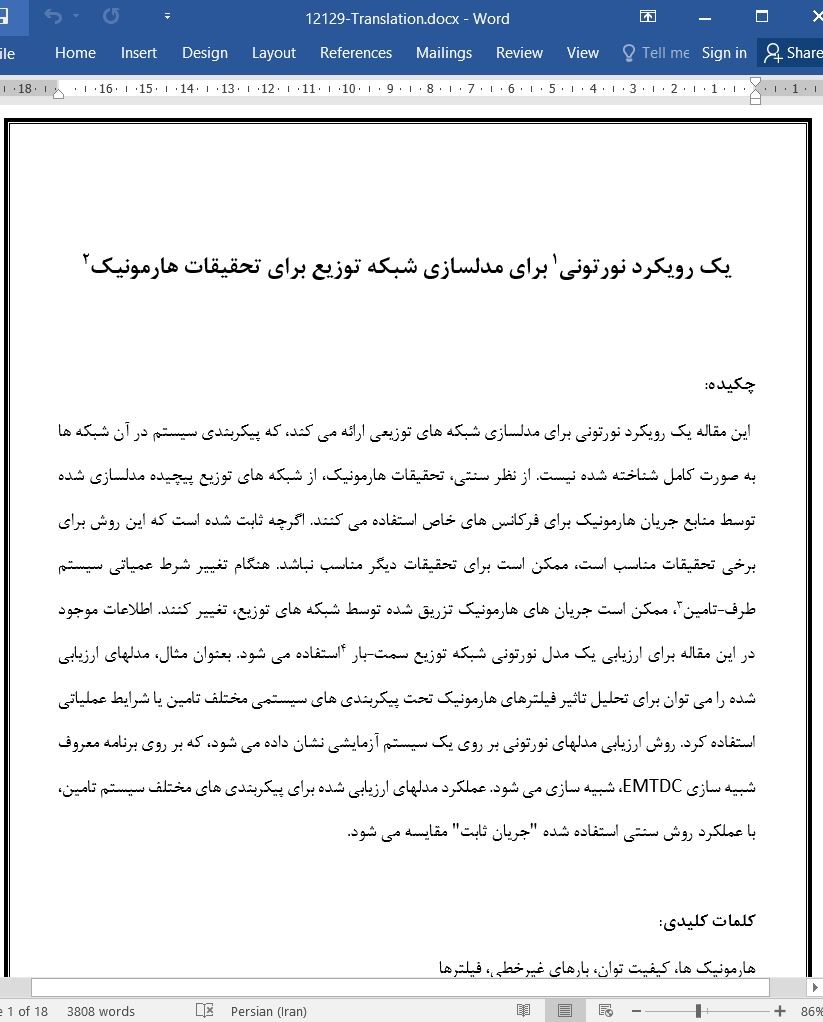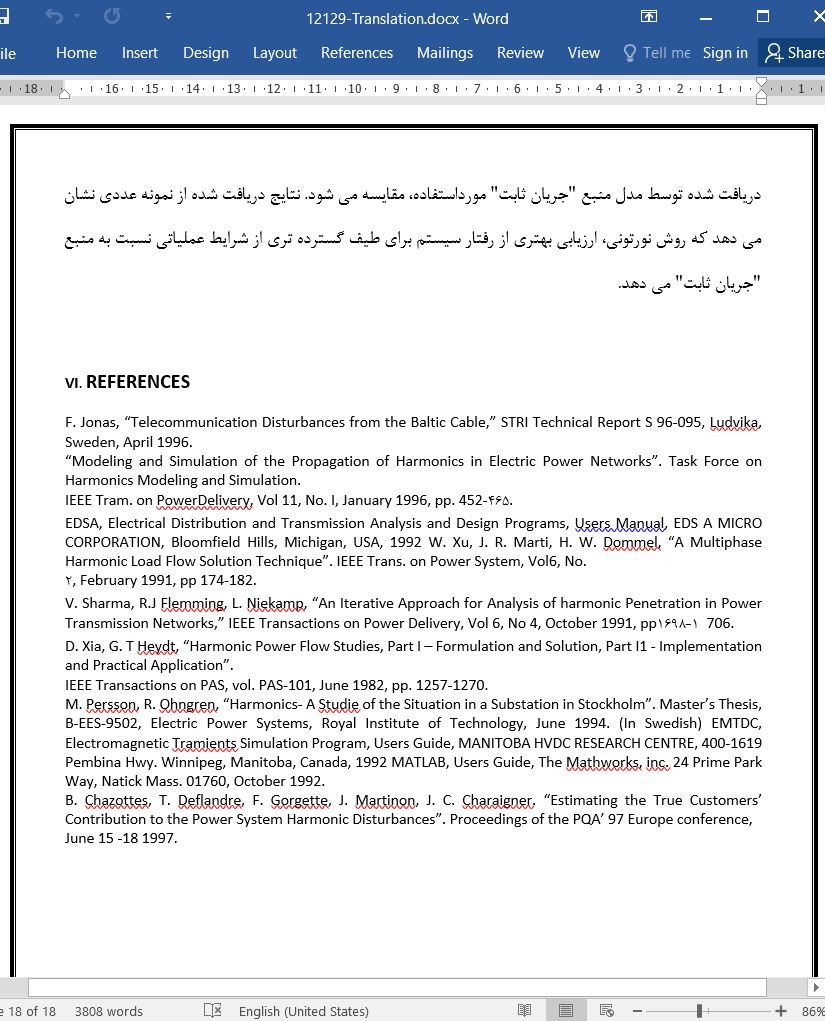
یک رویکرد نورتونی برای مدلسازی شبکه توزیع برای تحقیقات هارمونیک
چکیده
این مقاله یک رویکرد نورتونی برای مدلسازی شبکه های توزیعی ارائه می کند، که پیکربندی سیستم در آن شبکه ها به صورت کامل شناخته شده نیست. از نظر سنتی، تحقیقات هارمونیک، از شبکه های توزیع پیچیده مدلسازی شده توسط منابع جریان هارمونیک برای فرکانس های خاص استفاده می کنند. اگرچه ثابت شده است که این روش برای برخی تحقیقات مناسب است، ممکن است برای تحقیقات دیگر مناسب نباشد. هنگام تغییر شرط عمیاتی سیستم طرف-تامین ، ممکن است جریان های هارمونیک تزریق شده توسط شبکه های توزیع، تغییر کنند. اطلاعات موجود در این مقاله برای ارزیابی یک مدل نورتونی شبکه توزیع سمت-بار استفاده می شود. بعنوان مثال، مدلهای ارزیابی شده را می توان برای تحلیل تاثیر فیلترهای هارمونیک تحت پیکربندی های سیستمی مختلف تامین یا شرایط عملیاتی استفاده کرد. روش ارزیابی مدلهای نورتونی بر روی یک سیستم آزمایشی نشان داده می شود، که بر روی برنامه معروف شبیه سازی EMTDC، شبیه سازی می شود. عملکرد مدلهای ارزیابی شده برای پیکربندی های مختلف سیستم تامین، با عملکرد روش سنتی استفاده شده "جریان ثابت" مقایسه می شود.
I. مقدمه
در دهه های گذشته، استفاده از دستگاه های مبتنی بر الکترونیک قدرت در سیستم های قدرت، به صورت مداوم افزایش یافته است. دستگاه های الکترونیکی غیرخطی هستند و بنابراین جریان های ناهموار ایجاد می کنند، حتی زمانی که با ولتاژ صرفا سینوسی تغذیه می شوند. این جریان های ناهموار، باعث ایجاد اعوجاج ولتاژ و جریان در سراسر سیستم می شوند که منجر به گرم شدن بیشتر تجهیزات سیستم نیرو، سوئیچینگ بی دلیل بریکرها ، خاموش شدن فیوزها ، و تداخل با سیستم های ارتباطی می شوند [1]. همچنین این دستگاه های الکترونیکی به تغییرات کیفیت توان نسبت به تجهیزات استفاده شده در گذشته، حساس هستند. ریزپردازنده مبتنی بر کنترل های استفاده شده در این دستگاه های الکترونیکی نسبت به بسیاری از انواع اختلالات حساس هستند، که این مورد می تواند منجر به قطع مزاحمت، سوء استفاده یا خرابی واقعی دستگاه شود. این موضوع به یک نگرانی اصلی برای صنعت تبدیل می شود.
Abstract
This paper presents a Norton approach for modeling distribution networks where the system configuration is not fully known. Traditionally, harmonic studies use complex distribution networks modeled by harmonic current sources for specific frequencies. Although this approach has been proved to be adequate for some studies, this may not happen for other applications. When changing the operating condition of the supply-side system, the harmonic currents injected by the distribution network might change. This information is in this paper used to estimate a Norton model of the load-side distribution network. The estmated models can be used to analyze, for example, the effect of harmonic filters under different supply system configurations or operating conditions. The method of estimating the Norton models is illustrated on a test system, simulated on the well-known simulation program EMTDC. The performance of the estimated models is, for different configurations of the supply system, compared to the performance of the traditionally used “constant current” approach.
I. INTRODUCTION
The use of power electronics-based devices in power systems has increased steadily over the last decades. Electronics devices are nonlinear and thus they create distorted currents even when supplied with purely sinusoidal voltage. These distorted currents cause voltage and current distortion throughout the system which can result in additional heating in power system equipment, unmotivated switching of breakers, blowing of fuses, and interference with communication systems [ 11, These electronics devices are also more sensitive to power quality variations than equipment applied in the past. Microprocessor based controls applied in these electronics devices are sensitive to many types of disturbances which can result in nuisance tripping, misoperation or actual device failures. This is becoming a major concem for the industry.
چکیده
1. مقدمه
2. تاثیر سوئیچینگ خازن بر تولید هارمونیک شبکه
3. مدار نورتونی فرکانس-دامنه
A. ارزیابی معادله توِنن سیستم تامین
4. تشریح عملکرد مدل
A. سیستم آزمایشی
B. ارزیابی مدل
C. عملکرد مدل
5. نتیجه گیری ها
منابع
Abstract
1. INTRODUCTION
2. INFLUENCE OF CAPACITOR SWITCHING ON NETWORK HARMONIC GENERATION
3. FREQUENCY-DOMAIN NORTON CIRCUIT
A. Estimuting the supply system The'venm equivalent
4. ILLUSTRATION OF MODEL PERFORMANCE
A. Test System
B. Model Estimation
C. Model Performance
5. CONCLUSIONS
REFERENCES
- اصل مقاله انگلیسی با فرمت ورد (word) با قابلیت ویرایش
- ترجمه فارسی مقاله با فرمت ورد (word) با قابلیت ویرایش، بدون آرم سایت ای ترجمه
- ترجمه فارسی مقاله با فرمت pdf، بدون آرم سایت ای ترجمه



